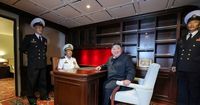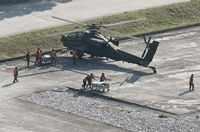On Monday, August 18, 2025, the Korean Peninsula once again found itself at the center of mounting military tensions and diplomatic uncertainty. As South Korea and the United States launched their annual Ulchi Freedom Shield military exercise, North Korean leader Kim Jong Un responded with sharp condemnation and a vow to rapidly expand his country’s nuclear capabilities. The latest moves, reported by outlets including the Associated Press and NBC News, highlight the persistent volatility in the region and the complex interplay of military posturing, political overtures, and historical grievances.
The Ulchi Freedom Shield exercise, which will run for 11 days and conclude on August 28, mobilizes a formidable force: about 21,000 troops, including 18,000 South Koreans, are engaged in both live and computer-simulated command post operations and field training exercises. According to the Joint Chiefs of Staff, the scale of this year’s drill mirrors that of previous years, despite some notable adjustments. Approximately 40 field training exercises were originally planned, but about half have been postponed until September due to extreme heat, safety concerns, and the need to maintain a balanced defense posture throughout the year. U.S. troop numbers remain undisclosed, but are expected to be similar to South Korean participation.
The decision to postpone some exercises, while officially attributed to weather and safety, has also been interpreted by observers as a gesture from South Korea’s new liberal President Lee Jae Myung. Since taking office in June, Lee has expressed a willingness to repair ties with Pyongyang and revive dialogue. Yet, as the Korea Herald notes, the overall scale of the drills remains unchanged, leaving little for North Korea to celebrate. "Although a part of the South Korea-US joint drill has been postponed, the exercise’s overall scale has been maintained, so there is nothing for North Korea to be particularly pleased about," said Hong Min, a senior researcher at the Korea Institute for National Unification.
North Korea’s response has been characteristically defiant. On Monday, Kim Jong Un was seen inspecting the Choe Hyon, a 5,000-ton-class destroyer being fitted with nuclear-capable systems at the western port of Nampo. State media described the warship as North Korea’s most advanced, designed to handle a range of weapons including antiair, anti-naval weaponry, and, crucially, nuclear-capable ballistic and cruise missiles. The Choe Hyon is expected to enter active duty next year, and Kim has ordered performance tests for October, reflecting the regime’s commitment to military modernization.
During his inspection, Kim did not mince words. According to KCNA, North Korea’s official news agency, he accused the South Korea-U.S. drills of displaying “hostility” and incorporating a “nuclear element,” which he claimed justified North Korea’s need for “proactive and overwhelming” countermeasures. "The security environment around the DPRK is getting more serious day by day and the prevailing situation requires us to make a radical and swift change in the existing military theory and practice and rapid expansion of nuclearization," KCNA paraphrased Kim as saying. The North’s stance is that the joint drills are not mere defense exercises but rehearsals for invasion—a claim it has made for decades.
Kim’s saber-rattling comes at a time when his regime has accelerated its nuclear weapons program and deepened ties with Moscow, especially since Russia’s invasion of Ukraine. The unveiling of a second destroyer, the Kang Kon, in May was marred by a failed launch, prompting Kim to call the mishap “criminal.” The vessel was subsequently relaunched in June after repairs, but some outside experts remain skeptical about its operational readiness. North Korea is also working to complete a third destroyer by October, further underscoring the regime’s focus on strengthening its naval and nuclear deterrent.
Meanwhile, in Seoul, President Lee Jae Myung’s administration is navigating a delicate balance. On the one hand, Lee has repeatedly voiced his desire to de-escalate tensions and restore the 2018 inter-Korean military agreement, which was designed to create buffer zones and prevent accidental clashes along the heavily fortified border. In a message to Pyongyang on Friday, August 15, Lee said he would seek to rebuild trust and revive talks. However, the agreement was suspended by South Korea in 2024 after North Korea launched trash-laden balloons across the border and resumed provocative activities. North Korea, for its part, had already declared it would no longer abide by the deal.
Despite these overtures, Pyongyang remains dismissive. Kim Yo-jong, Kim Jong Un’s influential sister, criticized the joint drills in July, stating that North Korea has “no interest” in reviving talks with Seoul. She further dismissed the postponement of some exercises as “futile.” North Korean Defense Minister No Kwang Chol echoed these sentiments last week, declaring that the drills represent a stance of “military confrontation” and warning that the North would be ready to counteract “any provocation going beyond the boundary line.”
The South Korean government, however, insists that the Ulchi Freedom Shield and the concurrent Ulchi civil defense drill—which involves about 580,000 participants from 4,000 institutions nationwide—are intended solely to protect the lives and safety of the population. The civil defense drill, running from August 18 to 21, includes air raid evacuation exercises and emergency vehicle passage drills. The presidential office has emphasized that the fundamental purpose of these exercises is to safeguard lives and achieve peace, not to heighten tensions. An objective evaluation of this year’s drill is planned to identify improvements for the future.
The stakes are high for President Lee as he prepares for an August 25 summit with U.S. President Donald Trump in Washington. Trump has previously raised concerns about the U.S.-South Korea alliance, demanding higher payments for the 28,500 American troops stationed on the peninsula and suggesting possible troop reductions as Washington shifts focus toward China. Experts warn that such shifts could leave Seoul with increased costs and risks while reducing the benefits of the longstanding alliance.
As the Ulchi Freedom Shield continues, the region remains on edge. Pyongyang’s reaction so far has been relatively muted—no immediate missile tests or dramatic provocations, though artillery drills or harsh rhetoric remain possibilities. Historically, North Korea’s responses have ranged from immediate weapons demonstrations to delayed, calculated moves designed to maximize diplomatic leverage.
For now, the Korean Peninsula stands as a vivid reminder of how quickly old animosities can flare, even as new leaders and shifting alliances attempt to chart a different course. Whether this summer’s drills and diplomatic gestures will open a new chapter or simply reinforce the hardened status quo remains to be seen.

